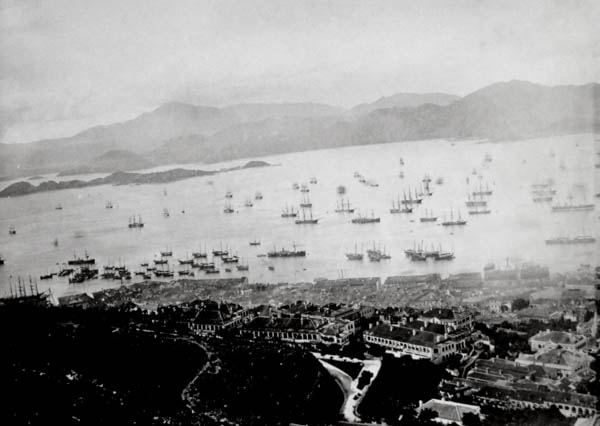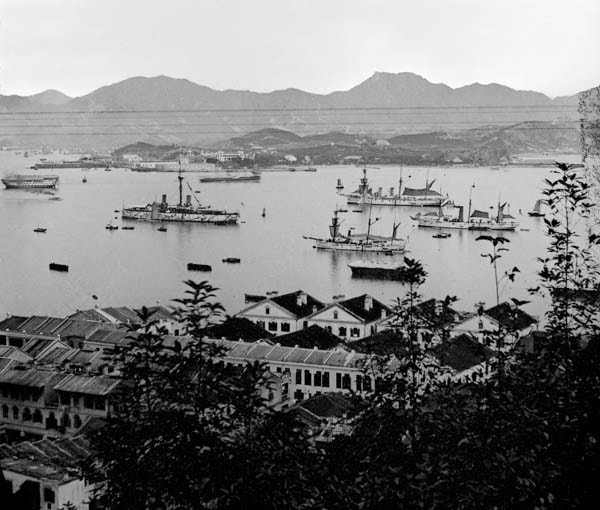The opium trade commenced in the late 18th century, initiated by British merchants as a means to counterbalance the deficit brought about by the bulk import of tea from China. Large-scale opium cultivation was established in India by the British East India Company, and the product was shipped to the mouth of the Pearl River for distribution inland by free traders who gained huge profits from the contraband trade. An imperial edict prohibiting the consumption, importation and cultivation of opium was issued in 1800. However, the contraband trade continued to grow. The import of opium rose from 5,000 chests in 1820 to 40,000 chests in 1838. The rapid growth of the opium trade eventually triggered hostilities between China and Britain when Emperor Daoguang, with the support of the imperial court, decided to take strong action to stop the illicit trade, which not only was detrimental to China’s economy, but also had adverse effects on the health of the people. The First Opium War ended two years later with the signing of the Treaty of Nanjing in 1842. There was no mention of opium in the treaty, and as a result, the contraband opium trade continued.
With a view to fostering a good relationship with China after the First Opium War, the first Governor, Sir Henry Pottinger, was instructed to forbid opium ships from using Hong Kong as a port. However, fearing that this action would not check the opium trade but only drive it into non-British hands, the British suspended the prohibition a year later.[22] Hong Kong thus became the hub of opium trades. The second Governor, Sir John Davis, once remarked that almost every person in Hong Kong in possession of capital and not connected with government employment was employed in the opium trade.[23] In fact, few of the leading firms in Hong Kong were not connected with the discreditable but profitable traffic in opium. For the period 1845-49, it is said that three quarters of the Indian opium crop were handled in Victoria Harbour, and that on average over 40,000 chests of opium worth 16 million pounds sterling were being stored in Hong Kong.[24] According to Sir Richard MacDonnell, Governor from 1866 to 1872, the whole amount of opium imported annually into Hong Kong was about 80,000 chests, of a total worth of about 11 million pounds sterling.
In the Treaty of Tianjin of 1858, opium was legalised. Foreign vessels, after paying the opium import tariff and lijin (釐金), were allowed to trade at the treaty ports. It also stipulated that opium should be carried into the interior only by Chinese vessels. The local Chinese junks, taking advantage of this treaty, carried opium and other goods into the mainland via non-Treaty ports, thus evading tax. The Chinese government, therefore, lost potential opium revenues. Starting from November 1867, nine marine and land customs stations were set up around Hong Kong, and Chinese customs revenue cruisers patrolled the nearby waters, searching for native craft smuggling opium or other goods. Some of these stations were at Fat Tau Chau, Cheung Chau, Kap Shui Mun and Lai Chi Kok. This was the so-called Chinese customs blockade of Hong Kong.[25] The blockade lasted from 1867 to 1886, and local trade suffered greatly as a result. Both foreign and Chinese merchants made official complaints from time to time, and they pressed the colonial government to take measures to resolve the matter. However, since the foreign community was against any interference with the freedom of the port, no progress was made.
In 1885, the Additional Article to the Agreement between Britain and China at Chefoo (1876) was signed in London. The article stipulated that all imported opium was subject to a tariff at a rate of 30 taels per chest of 100 catties and also a sum not exceeding 80 taels per chest as lijin levied by the Imperial Maritime Customs. Certificates would be issued once the tariff and lijin were paid and would free the opium from imposition of any further taxes or duties whilst it was being transported to the interior. Subsequent to the signing of this additional article, an Imports and Exports Office was set up under the Harbour Master in 1887 to record and control shipments of opium in and out of the city. The blockade of Hong Kong thus came to an end.
From the 1880s onwards, the import of opium was on a downward trend. It faced competition from Chinese-grown opium, which was much cheaper. On the other hand, under mounting pressure from the Church and the British Government, Hong Kong was forced to close its opium dens and to cease exporting the prepared drug to China. The opium trade eventually came to an end in 1917.[26]
The Royal Navy was quick to build a store at present day Admiralty shortly after Hong Kong’s inception. Jardine Matheson & Co., which had acquired land at East Point, followed suit. The Jardine godowns remained for well over a century, until being demolished in the early 1950s for residential development. In around 1845, the Wan Chai district at the foot of Hospital Hill along Queen’s Road East became a godown area with piers stretching into the harbour, something apparent from old photographs of that period. The Albany Godowns built in 1844 near present-day Tai Yuen Street contained two ranges of sixteen godowns with walls two-feet thick capable of storing about 30,000 bales of cotton. Other commercial firms lost no time in building their own godowns as Hong Kong’s entrepot trade grew. From the early 1860s Augustine Heard & Co., W. R. Landstein & Co., and Burrows & Sons, among others, built their warehouses at the foot of Hospital Hill along Wan Chai Road. Hong Kong Pier and Godown Co. built godowns with steam cranes, engines and wagons in 1872. The property was bought by the Wan Chai Warehouse and Storage Co. in 1891, and was leased by the Kowloon Wharf and Godown in 1896. Meanwhile, an extensive tract of land on the sea front in Sheung Wan came into the possession of the Peninsula & Oriental Steam Navigation Co., which built warehouses on the lots. Towards the end of the century they were bought by Jardine Matheson & Co. and were later transferred to the newly organised Hong Kong & Kowloon Wharf & Godown Co.
From the 1870s, as the population grew and more land became required for tenement buildings to accommodate new immigrants, godowns in Wan Chai were gradually moved to Kennedy Town, a newly reclaimed area in the western part of Hong Kong Island. The waterfront of Kennedy Town was lined with rows of godowns for the storage of all varieties of goods. It remained a godown area for well over a century until new developments in the 1990s.
Another major godown area was in Kowloon at Tsim Sha Tsui along Canton Road. In 1886, the Hong Kong & Kowloon Wharf & Godown Co. Ltd. was founded. It soon developed the largest and most modernised wharf and godowns in Hong Kong. The buildings occupied a substantial part of the western side of Kowloon Peninsula. At the turn of the century, the godowns had a storage capacity of 500,000 tons. Business was given a further fillip after the completion of the Kowloon and Canton Railway in 1911.
From old photographs it can be seen that since the early days most ships had anchored in Victoria Harbour to the west of Kowloon Peninsula, which was the widest part of the harbour. Goods were transported to land by barges and passengers and crew by ferries. This remains so even today. Following the advance of the age of containerisation, container ports were built at Kwai Chung for containers to load and unload their goods.[27]
Notes:
- [22]Endacott, A History of Hong Kong, pp. 43-44.
- [23]Ibid., p. 73.
- [24]余繩武、劉存寬:《十九世紀的香港》(香港:麒麟書業有限公司,1994),頁228。
- [25]Endacott, A History of Hong Kong, pp. 189-194, 213-214.
- [26]Solomon Bard, Traders of Hong Kong: Some Foreign Merchant Houses, 1841-1899, pp. 49-50.
- [27]Carl Smith, ‘Wan Chai: In Search of an Identity’, in A Sense of History: Studies in the Social and Urban History of Hong Kong (Hong Kong: Hong Kong Educational Publishing Co., 1995).




